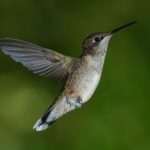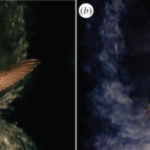Paper, Hummingbird Flight Performance in Variable Aerial Environments
Abstract: Hummingbirds are well known for their ability to sustain hovering flight, but many other remarkable features of manoeuvrability characterize the more than 330 species of trochilid. Most research on hummingbird flight has been focused on either forward flight or hovering in otherwise non-perturbed air. In nature, however, hummingbirds fly through and must compensate for substantial environmental perturbation, including heavy rain, unpredictable updraughts and turbulent eddies. Here, we review recent studies on hummingbirds flying within challenging aerial environments, and discuss both the direct and indirect effects of unsteady environmental flows such as rain and von Kármán vortex streets. Both perturbation intensity and the spatio-temporal scale of disturbance (expressed with respect to characteristic body size) will influence mechanical responses of volant taxa. Most features of hummingbird manoeuvrability remain undescribed, as do evolutionary patterns of flight-related adaptation within the lineage. Trochilid flight performance under natural conditions far exceeds that of microair vehicles at similar scales, and the group as a whole presents many research opportunities for understanding aerial manoeuvrability.
Learn about our two Decals!
 Click here to find out more about our Fall Bioinspired Design Decal and our Spring Bioinspired Design in Action Decal – ALL MAJORS are welcome.
Click here to find out more about our Fall Bioinspired Design Decal and our Spring Bioinspired Design in Action Decal – ALL MAJORS are welcome.Berkeley BioDesign Community
 Click here to learn about the BioD: Bio-Inspired Design @ Berkeley student organization or here to signup for more info.
Click here to learn about the BioD: Bio-Inspired Design @ Berkeley student organization or here to signup for more info.Search
Student Login





I imagine that the neurological circuits underlying these processes are governed by both 2d spacing maps with their brains as…
to reduce the impact of car accidents, it may be possible to study the force diverting physics of cockroaches to…
you see this type of head-bobbing stability in many avian creatures related to pigeons like chickens. the head ability to…
not like they taught horses how to run! this is an example of convergent evolution where both sea creatures and…
The brain functions in a similar way with neuronal connections. our brains are able to utilize the multiplicity of connections…